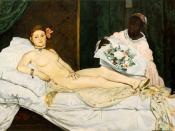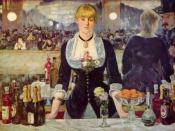Before attempting to anaylse the significance of gender within Edouard Manetùs work entitled óA Bar at the Follies-Bergereò, one must first identify , and note, the somewhat colorful events which occurred within the artist life, and note the way in which they must have undoubtedly prejudiced his work.
Born in France in 1832, Manet was raised by his parents Auguste and Eugenie-Desiree; a society couple, who's social standing resulted from Augusteùs successful career in the Ministry of Justice , Paris. Indeed, so successful was Auguste in his chosen field that upon his retirement he was awarded the Legion of Honor. It is thought by many that the importance of Augusteùs role in both society and the ministry actually intimidated the young Manet, who constantly aspired throughout his adult life, to gain the same level of reverence as that which his father possessed.
In fact so intrinsic is Manetùs personal background to the analysis of the artists treatment of gender within his work, that any substantial theory concerning this subject must, be founded upon a detailed study of the artists formative years.
Such a personal focus as this, allows the particularities found within Manetùs relationships with women to become apparent, and therefore, in part, aids the understanding of the complex interactionalism found between the characters within his painted scenes.
However, it is the actions of the artists youth which many theorists believe is the key to understanding the ambiguous portrayal of woman within his painting of óA Bar at the Follies-Bergereò. It was during the late 1850ùs when Manet was serving as a naval cadet in Rio de Janeiro, that he met a number of slave girls, Manet had openly admitted in letters to his friends the extend to which he found their tropical beauty alluring. Yet, is...


